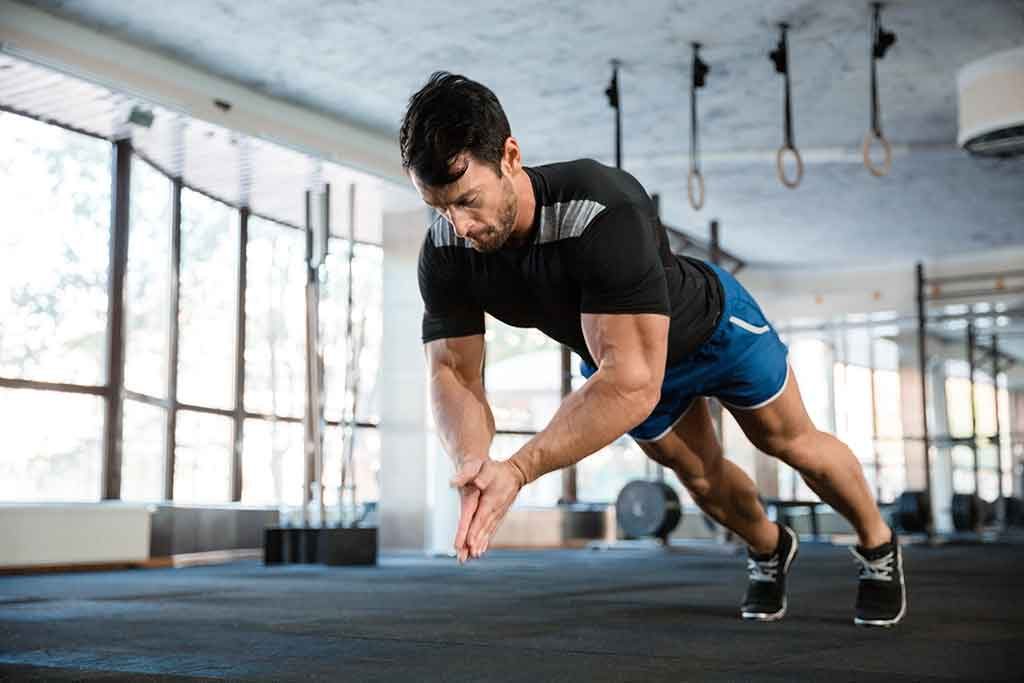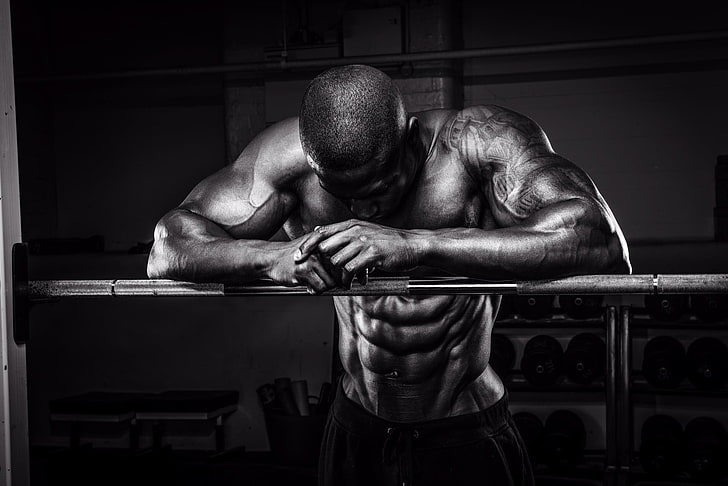Contrast training involves performing a strength exercise followed by a power movement similar to the strength movement. Examples: a Deadlift paired with a Broad Jump, or Bench Press paired with a Plyometric Pushup. This training method develops strength, and explosive power. For anyone looking for a career in personal training, reach out to the Fit Education team today or read about our Personal Training Courses. Otherwise, read on to find out more about contrast training.

How Does Contrast Training Work?
Contrast training is an advanced training method that combines high-load strength movements with biomechanically similar plyometric movements. Post-Activation Potentiation PAP refers to the enhancement of muscle function following high force activity. Sports scientists have found that heavy loading prior to an explosive movement induces a high degree of central nervous system stimulation, resulting in greater motor unit recruitment and force, lasting from five to 30 minutes.1 In other words, a heavy strength movement can lead to enhanced muscle function and optimum conditions for performing a subsequent explosive movement that engages the same muscle groups.
It is important to note that when you perform a heavy strength movement, or max contraction, there is always a trade-off between fatigue and the potentiation effect. Athletes who have not made resistance training adaptations will most likely be too fatigued after the initial strength movement to benefit from PAP. The strength movement should be heavy; ie. 4-5 sets of 2-4 reps. Move directly from the strength movement, into the explosive movement.
Studies have shown a great deal of individual variability in terms of when the potentiation effect occurs. The execution of high-intensity contractions prior to competition can enhance performance.
Athletes who cannot immediately take advantage of PAP can still benefit from contrast training, as it allows them to train for athleticism and power during a strength workout. Once a foundation is built and adaptations are in place, athletes can expect their muscles to create more explosive power.
Along with short- and long-term power adaptations, taking advantage of PAP through contrast training is an excellent way to increase training density. This directly affects work capacity and is essential for building the type of anaerobic energy system and muscle endurance that allow an athlete to give maximal effort throughout the course of a competition or practice.
Programming Contrast Training
Overload – Dow what you always did = Get what you always got.
As human beings, we adapt to a training stimulus. Programming and planning is important to ensure progression. To keep making progress in the weight room, you need to create overload. Read more on progressive overload here.
At Fit Education we use phases of contrast training for 3-4 weeks depending on training age, time of the year, and the goal of the phase. We typically use contrast training when the athletes have to peak for an event, or their season. We also use it when an athlete has been training for a while and needs to break up the training and introduce a new stimulus to adapt to. It also helps to vary the training and keep the athlete interested.
It is important to have a foundation of strength before starting contrast training. For a person to be ready for contrast training, they should have trained consistently for at least six months and be lifting heavy weights. This will ensure the body is structurally ready for the additional explosive demands.

Program Considerations
The most important factors to a successful contrast training session are:
- Use foundational movements (think Deadlift, Squat, Bench Press and pulling variations) for the heavy lift.
- Avoid using isolation exercises such as Band Bicep Curls as the heavy lift. We’re looking to build large muscle groups, not just grow one muscle.
- Appropriate rest is key. After completing the strength movement, it should take no longer than 10-15 seconds to get to the explosive movement. If it does, then you went to heavy on the movement. After you complete the explosive movement, you can rest for 1-3 minutes before staring another set.
- Intent is everything. The explosive movements should be explosive. You should be thinking one jump at a time and trying to touch the sky, not just trying to complete them as fast as possible.
- Do a couple of warm-up sets as the “strength” lift needs to be heavy. Perform 1-3 sets of 2-3 reps at lighter weights just to make sure the movement pattern is primed but not fried.
The rest of the session
The rest of the session depends on goals and what else is planned for the week. That’s why having a plan is so important. It could look something like this to create a full body workout.
| Exercises | Sets | Reps | Rest | |
| A1 | Front Squat | 4 | 4 | 10-15 secs |
| A2 | Jump for height | 4 | 3 | 1-3 Mins |
| B1 | Single Leg RDL | 3-4 | 6-8 | 10 -15 secs |
| B2 | Bench Pull | 3-4 | 8-10 | 10-15 secs |
| B3 | Stability Ball Stir the Pot | 3-4 | 10 | 10-15 secs |
| C | Stretch and trigger | – |
The reason for including some wiggle room with the number of sets and reps on the second super set is because we have to listen to our body. The goal is to become stronger and more powerful, not to leave the gym totally exhausted and incapable of performing any more work. Performing a ton of accessory work after your contrast training may not be the best approach. Work smarter, not harder. You can consider seeking personalised advice from the best mobile personal trainer for training implementation.
Contrast Set Pairs
| Strength Exercise (Heavy) | Explosive Exercise |
| Bench Press | Plyo Push-Up |
| Squat | Squat Jump |
| Deadlift | Standing Broad Jump |
| Standing Barbell Shoulder Press | Overhead Med Ball Throw |
| Split- Squat | Split-Squat Jumps |
| Snatch or Clean | Jump Squat |
Example contrast workout
| Exercises | Sets | Reps | Rest | |
| A1 | Back Squat @ 90% max | 3 | 3 | 10-15 secs |
| A2 | Squat Jump | 3 | 3 | 3 Mins |
| B1 | Bench Press @ 90% max | 3 | 3 | 10 -15 secs |
| B2 | Clap Push Up | 3 | 3 | 3 mins |
| C1 | Deadlift @ 90% max | 3 | 3 | 10-15 secs |
| C2 | Standing Long Jumps | 3 | 3 | 3 mins |
Rest for 3 minutes and repeat for 3 rounds.
Focus on explosiveness during the power exercise. Do 2 x warm-up sets of each pair before work sets.

Summary: The Three Keys of Contrast Training
- Build the Foundation First
Build a movement and strength foundation before trying this technique. If you’ve already been training consistently and lifting heavy for several consecutive months, you should be ready to take on constant training (as long as your form is also on point and you have experience with the moves you’ll be using in your contrast training). - Move With Intent
Whether it’s the strength or power movement, you need to move with a purpose. Move the bar as fast as possible and jump as high or far as you can. - Be Smart
Control the overload. Consistent progress is progress, so don’t make huge jumps set to set or week to week. Be smart with the weights and be smart with programming contrast training. Once you’ve completed a 3- to 4-week phase of contrast training, wait at least another eight weeks before beginning another phase of contrast training
Want to learn more about Fitness and Training?
Check out these other blogs!
- Bulking Up and Gaining Strength – Fit Education
- Preventive health (fiteducation.edu.au)
- Tapering – Fit Education
- How to Become a Mobile Personal Trainer
You may also go on to complete your studies in Certificate III & IV in Fitness where a wide range of expertly written materials will expand your knowledge and practical experience, with Certificate 3 and 4 in Fitness (Personal Trainer Course) – Fit Education.
Reference
1. Chiu, L.Z., Fry, A.C., Weiss, L.W., Schilling, B.K., Brown, L.E., & Smith, S.L. (2003). “Postactivation potentiation response in athletic and recreationally trained individuals.” Journal of Strength and Conditioning Research. 17(4), 671-677.
Training techniques such as contrast training are covered in the Certificate III in Fitness, Certificate IV in Fitness and Diploma of Sport.
Tagged Bulking UpCert 4 in FitnessCertificate IV in FitnessContrast TrainingHypertrophyPersonal TrainingPowerResistance TrainingStrength and ConditioningStrength Training
